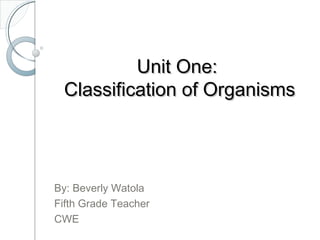
Unit1 ppt Classification of Organisms
- 1. Unit One:Unit One: Classification of OrganismsClassification of Organisms By: Beverly Watola Fifth Grade Teacher CWE
- 2. EQ: How are living thingsEQ: How are living things grouped?grouped? S5L1. Students will classify organisms into groups and relate how they determined the groups with how and why scientists use classification. Demonstrate how animals are sorted into groups (vertebrate and invertebrate) and how vertebrates are sorted into groups (fish, amphibian, reptile, bird, and mammal). Demonstrate how plants are sorted into groups.
- 3. I can explain why scientist classify living things.
- 4. Lesson 1- P. 266-275Lesson 1- P. 266-275 ClassificationClassification Classification is the grouping of similar things together. By identifying characteristics that living things share, scientists can group similarities, like the way that organisms look, live, eat move, grow, change and reproduce.
- 5. How might classification helpHow might classification help scientist?scientist? Think-Pair-Share:
- 6. Great ideas!Great ideas! Classification is the process of grouping things together. It is useful in studying how living things are alike and how they are different. Classification makes finding and sharing information and sharing information easier.
- 7. Grouping Living ThingsGrouping Living Things Scientist classify living things into major groups called kingdoms. Members of each group have certain characteristics. Kingdoms Animals: •Made of many cells, •Feed on other living or once living things Plants: •Made of many cells •Make their own food Fungi: •Made of many cells •Don’t make or eat food •Absorb food Bacteria: •Single celled organisms •Cells have no nucleus •Some make food •Most absorb food Protist: •Mostly single celled •Some make food •Others take in food * Note: Sometimes bacteria is divided into two groups.
- 8. Smaller GroupsSmaller Groups Kingdoms are divided in to smaller groups. Each smaller group shares more and more of the same characteristics.
- 9. SpeciesSpecies Species is the smallest group. Species means a unique kind of organism. Species is an exact group of one kind of organism.
- 10. Lesson 2-pp. 280-290Lesson 2-pp. 280-290 EQ: What are vertebrates and invertebrates? I can demonstrate how vertebrates and invertebrates are classified into groups.
- 11. Vertebrates and InvertebratesVertebrates and Invertebrates Vertebrates are animals with a backbone: Examples: human, cat, dog, giraffe, snakes Invertebrates are animal without a backbone. Examples: sponges, jellyfish, anemones, and coral
- 12. More About VertebratesMore About Vertebrates There are five phyla of vertebrates. 1. Fish – Absorb oxygen that is dissolved in water (trout and shark) 2. Amphibian-Begin life in water, Many live on land but return to water to lay eggs (frogs and toads) 3. Reptiles-Scaly skin, most lay eggs i 4. Birds-Have feathers, most fly, not all 5. Mammals-Have hair and produce milk for their young
- 13. More about InvertebrateMore about Invertebrate Invertebrates are the largest part of the animal kingdom. Invertebrate include: sponges jellyfish, anemones and coral. Many echindoderm have spines and body parts arranged in multiples of five. (ie. Starfish, sand dollars and sea urchins Anthropods are the most common group. The have joined legs and bodies that have segments.
- 14. Structure and FunctionStructure and Function Structure is the form of a body part. Function is what a structure does. For example, a wing is a structure and flight is its function.
- 15. What are some other examples ofWhat are some other examples of form and structure?form and structure? Turn to your partner and share an example of structure and function.
- 16. Lesson 3 - pp, 292-300Lesson 3 - pp, 292-300 How are plants sorted into groups?How are plants sorted into groups? Nonvascular Plants: Plants that do not havetrue roots, but are anchored in the ground by small root-like structures. (mosses) Vascular Plants: Plants that have tissue that supports and carries food and water. Vascular means “vessel” and the function of the vascular tissue to to transport water and nutrients. (roots, stems, and leaves)
- 17. Two Types of Vascular TissueTwo Types of Vascular Tissue Xylem: carries water and nutrients from roots to other parts of a plant. Phloem: carries food from leaves to the rest of the plant.
- 18. Think – Pair – ShareThink – Pair – Share Name three examples of vascular plants. Explain how vascular and nonvascular plants are different.
- 19. Seed Bearing PlantsSeed Bearing Plants Gymnosperm- a plant produced by a naked seed (or a seed that is not protest by a fruit. It is only protected by a seed coat) Angiosperm- a flowering plant, which has its seeds protected by a fruit
- 20. Think – Pair - ShareThink – Pair - Share Think of three example of gymnosperms. Think of three examples of angiosperms
